
A seashell or sea shell, also known simply as a shell, is a hard, protective outer layer usually created by an animal or organism that lives in the sea. Most seashells are made by mollusks, such as snails, clams, and oysters to protect their soft insides. Empty seashells are often found washed up on beaches by beachcombers. The shells are empty because the animal has died and the soft parts have decomposed or been eaten by another organism.

Bivalvia or bivalves, in previous centuries referred to as the Lamellibranchiata and Pelecypoda, is a class of aquatic molluscs that have laterally compressed soft bodies enclosed by a calcified exoskeleton consisting of a hinged pair of half-shells known as valves. As a group, bivalves have no head and lack some typical molluscan organs such as the radula and the odontophore. Their gills have evolved into ctenidia, specialised organs for feeding and breathing.

Santa Barbara Island is a small island of the Channel Islands archipelago in Southern California. It is protected within Channel Islands National Park, and its marine ecosystem is part of the Channel Islands National Marine Sanctuary. Public passenger access to Santa Barbara Island is provided by the Island Packers ferry service.

A cockle is an edible marine bivalve mollusc. Although many small edible bivalves are loosely called cockles, true cockles are species in the family Cardiidae.
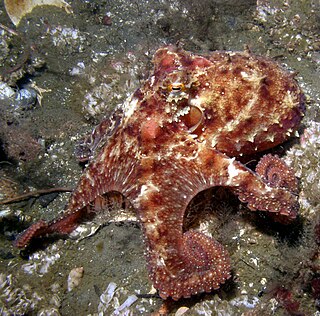
Octopus rubescens is the most commonly occurring shallow-water octopus on much of the North American West Coast and a ubiquitous benthic predator in these habitats. Its range extends from the southern Gulf of California to at least the Gulf of Alaska, but may also occur in the western Pacific Ocean. O. rubescens occurs intertidally to a depth of 300 m (980 ft).
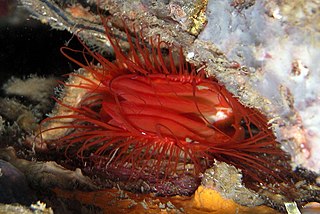
The Limidae or file shells are members of the only family of bivalve molluscs in the order Limida. The family includes 130 living species, assigned to 10 genera. Widely distributed in all seas from shallow to deep waters, the species are usually epifaunal or nestling, with many species building byssal nests for protection. The majority of species are capable of irregular swimming by waving their long mantle tentacles.

Perna perna, the brown mussel, is an economically important mussel, a bivalve mollusc belonging to the family Mytilidae. It is harvested as a food source but is also known to harbor toxins and cause damage to marine structures. It is native to the waters of Africa, Europe, and South America and was introduced in the waters of North America.

Manzanellidae is a fossil family of bivalves, in the order Solemyida. They were previously considered containing fossil and recent members of Nucinellidae.
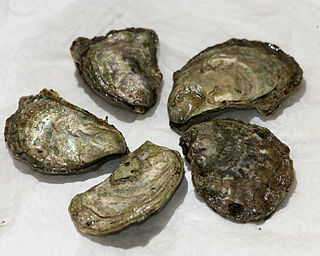
Ostrea lurida, common name the Olympia oyster, after Olympia, Washington in the Puget Sound area, is a species of small, edible oyster, a marine bivalve mollusk in the family Ostreidae. This species occurs on the northern Pacific coast of North America. Over the years the role of this edible species of oyster has been partly displaced by the cultivation of non-native edible oyster species.
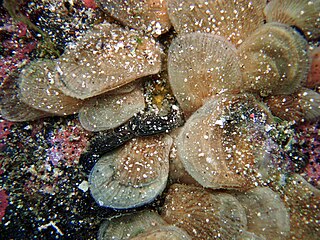
Isognomon is a genus of marine bivalve mollusks which is related to the pearl oysters.
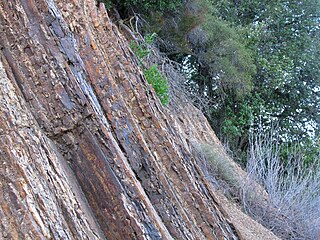
The Jalama Formation is a sedimentary rock formation widespread in southern Santa Barbara County and northern Ventura County, southern California. Of the Late Cretaceous epoch, the unit consists predominantly of clay shale with some beds of sandstone.
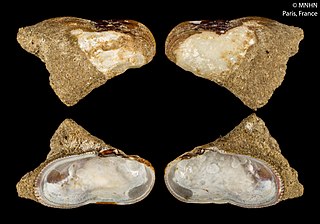
Gregariella is a genus of mussels in the family Mytilidae.

Pholas is a taxonomic genus of marine bivalve molluscs in the subfamily Pholadinae of the family Pholadidae.

Gastrochaena is a genus of saltwater clams, marine bivalve molluscs in the family Gastrochaenidae. The type species of this genus is Gastrochaena cuneiformis.

Sanguinolaria is a genus of saltwater clams, marine bivalve molluscs of the family Psammobiidae.

Ostreoidea is a taxonomic superfamily of bivalve marine mollusc, sometimes simply identified as oysters, containing two families. The ostreoids are characterized in part by the presence of a well developed axial rod. Anal flaps are known to exist within the family Ostreidae but not within the more-primitive Gryphaeidae. The scar from the adductor muscle is simple, with a single, central scar. In the majority, the right valve is less convex than the left.

The Anomioidea are a superfamily of marine bivalve molluscs that include two families, the Anomiidae and the Placunidae, the jingle shells and saddle shells. They are mainly sessile bivalves that superficially resemble true oysters. Though they are pleurothetic, however, the Anomioidea attach via their right valve rather than the usual left. Their irregular shells are inequilateral, are round to oval, with a large byssal notch. The byssus itself is usually short and plug-like. The left valve is convex, and the hinge is considered edentulous.

Modiolus capax, common name fat horsemussel, is a species of "horse mussel", a marine bivalve mollusc in the family Mytilidae, the mussels. It was first described to science by American malacologist Timothy Abbott Conrad in 1837. The type specimen was collected in San Diego by Thomas Nuttall.

Eurytellina simulans is a species of bivalve mollusc. This species was previously known as Tellina simulans.

Adrana is a genus of bivalves belonging to the family Nuculanidae.




















